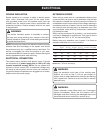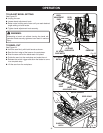
15
OPERATION
If at any time the lower blade guard does not snap closed,
unplug the saw from the power supply. Exercise the lower
guard by moving it rapidly back and forth from the full open
position to the closed position several times. Normally this
will restore the guard to its normal operating condition. If
it does not correct a slow or sluggish closing lower guard,
do not use the saw. Take it to an authorized factory service
center for repair.
STARTING/STOPPING THE SAW
See Figure 12.
To start the saw: Depress the switch trigger.
Always let the blade reach full speed, then guide the saw
into the workpiece.
WARNING:
The blade coming in contact with the workpiece before
it reaches full speed could cause the saw to “kickback”
towards you resulting in serious injury.
To stop the saw: Release the switch trigger.
After you release the switch trigger, allow the blade to come
to a complete stop. Do not remove the saw from the
workpiece while the blade is moving.
ADJUSTING BLADE DEPTH
See Figure 13.
Always keep correct blade depth setting. Less than a full tooth
of the blade teeth should be visible below the workpiece.
More blade depth will increase the chance of kickback and
cause the cut to be rough. For more depth of cut accuracy,
a scale is located on the upper blade guard.
To adjust the blade depth:
Unplug the saw.
Loosen depth adjustment knob.
Determine the desired depth of cut.
Locate depth of cut scale on back of upper blade
guard.
Hold base flat against the workpiece and raise or lower
saw until the index point (or reference mark) on bracket
aligns with notch on blade guard.
Tighten depth adjustment knob securely.
Fig. 13
DePTH
aDJuSTMeNT
KNOB
DePTH Of
CuT SCaLe
Fig. 12
SwiTCH
iNDex POiNT


















